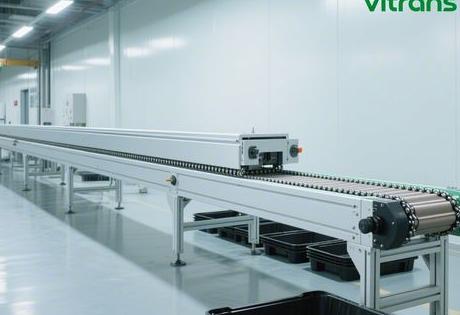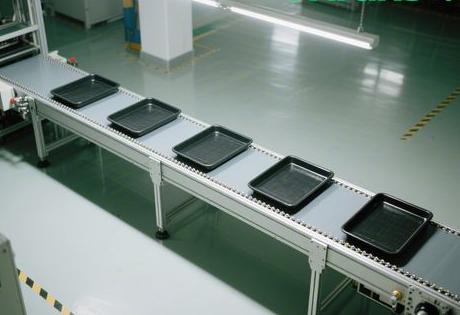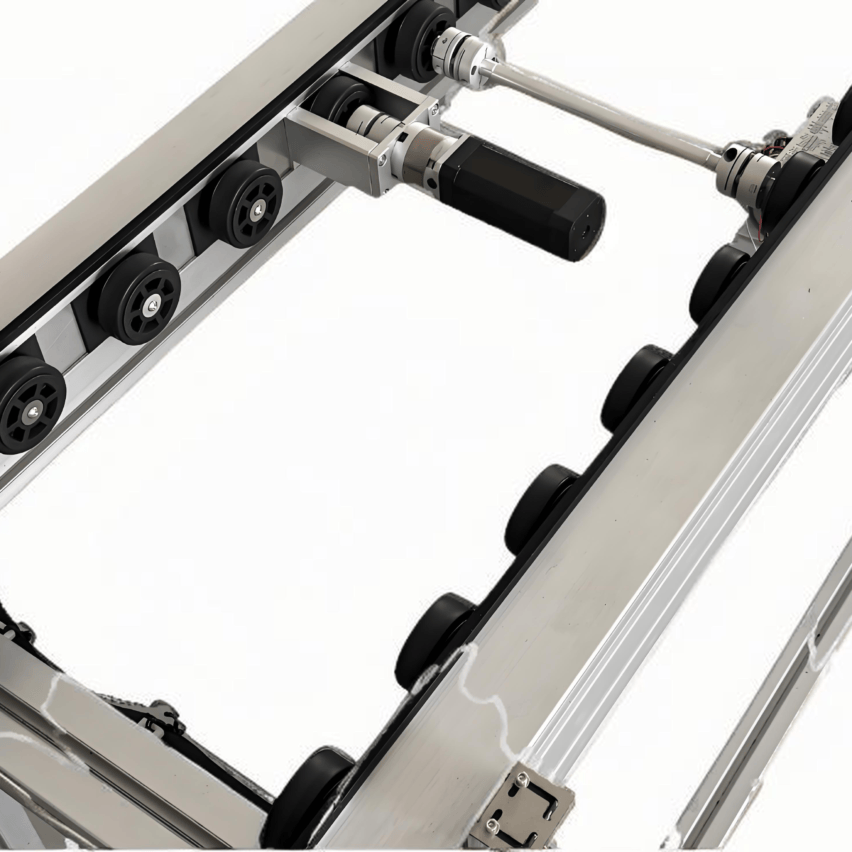In the field of industrial conveying, a 5mm thick friction strip is rewriting the physical rules of multiplier chains - by precisely controlling the roller friction interface, it enables ordinary roller chains to gain 2x speed capacity while reducing heavy-duty energy consumption by 15%.

I. The nature of technology: the precise game of friction coefficients
The core value of the 5mm speed chain friction strips areReconstructs the mechanical relationship between the roller and the chain. Its design logic is based on the synergy of three laws of physics:
- Friction coefficient window controlThe coefficient of friction is stabilised in the range of 0.08-0.16 by means of a special polymer material formula (containing a molybdenum disulphide-modified component). Lower than 0.08 will lead to roller slippage, higher than 0.16 will accelerate wear.
- Diameter ratio energy conversion: When the friction bar is in contact with the large wheel (diameter D), according to the equationTotal V = V₁ x (1 + D/d)Diameter ratio D/d = 1 for 2x speed conversion (D/d ≥ 1.5 for conventional chain).
- Elastic deformation compensationThe 5mm thickness design absorbs ±0.3mm of track deformation, avoiding abnormal wear caused by local stress concentrations.
case-based evidence: An automotive parts factory used this solution to modify the roller chain when conveying a 2 tonne engine block:
- Speed increase from 1.2m/min to 2.4m/min
- Motor power inversion 15% (due to reduced friction losses)
confirm"Friction control is superior to power stacking."The law of energy efficiency.
II. Structural innovations: modular design for downscaling
Differing from the traditional integral doubling chain, the 5mm friction bar passes through theInterchangeable modulesRealisation of functional upgrades:
1. Limit slot topology revolution
- The first type of friction strip limit groove (width 5.2±0.05mm) accurately matches the standard friction strip, with an interference control of 0.15mm.
- The bottom positioning projection adopts dovetail structure, with a shear strength of 120MPa (only 80MPa for ordinary slot).
2. Triple friction interface switching
Friction bar type contact position functionality doubling effect first type Chain middle big wheel Roller chain → Speed doubling chain 2x speed category 2 Small wheels on both sides of the chain maintenance of accumulated functions 1x speed category 3 lower pulley Anti derailment + auxiliary load – 3. Dynamic compensation mechanisms
Under a load of 800kg, the friction bar produces 0.18mm of elastic deformation, which exactly compensates for the thermal expansion gap of the chain (4.8mm elongation for a 40 metre line at 10°C) without the need for an additional tensioning device.
III. Engineering value: Pareto-optimality of cost and effectiveness
1. Conversion costs fall off a cliff
- Traditional speed chain upgrade programme: ¥1.2-1.5 million/hundred metres
- Friction bar retrofit programme: ¥180,000-220,000/100m (including profile cutting and installation)
The case of the Yantai fittings factory shows thatPayback in 14 months2. Space adaptation breakthroughs
- L-corner mountable on jacking traverse module (min. radius 1.2m)
- Support -15℃~85℃ environment operation (food factory freezing workshop verification)
3. Preservation of the revolution
Modular design makes the replacement time consuming from 8 hours → 40 minutes, and the annual maintenance cost of a lithium battery factory is reduced by 830,000 RMB.
IV. Materials science: molecular-level victories in nanomodification
At the heart of determining the life of a 5mm friction strip isMaterial formula breakthroughs::
- substratesPolyamideimide (PAI) has a temperature resistance index of 250°C, which is 70% higher than conventional nylon.
- reinforcing fibreCarbon nanotube (CNT) content 12%, friction coefficient fluctuation range compressed to ±0.02
- Solid lubricants: Molybdenum disulphide nanosheets (layer thickness 2.3 nm) to fill microscopic pits and form self-healing membranes
Extreme test data::
After 100,000 cyclic wear tests, the surface roughness Ra only increased from 0.8μm to 1.2μm (conventional engineering plastics from 1.0μm → 3.5μm), extending the life span by 4 times.
V. Future battlegrounds: cognitive leaps in smart friction
1. Dynamic friction coefficient adjustment system
Laboratory prototypes have been realised:
- Piezoelectric ceramic microcells for real-time sensing of contact stresses
- Electrorheological materials adjust the coefficient of friction in 0.1 seconds (range 0.07-0.22)
Seamless switching of the same chain between 2x speed/accumulation modes2. Energy-recovery friction interfaces
Graphene thermoelectric modules are embedded in friction strips to generate electricity using temperature differences:
- Contact surface temperature difference ΔT ≈ 35 ℃ when
- Over 5200 kW-h per 100 metres of lineal body per year (to meet lighting system requirements)
3. Digital twin operations and maintenance
Learning wear trajectories through AI:
- Predicts replacement cycles with an accuracy of ±3 days
- Reduction of funds tied up in spare parts holdings by 67%
Self-questioning: penetrating the technological fog
Q1: How can 5mm thickness solve the problem of heavy-duty slipping?
Principle of elastic deformation energy conversion::
- 0.18mm compression of the friction strip under 800kg load, increasing the contact area by 28%.
- Pressure from 1.8MPa → 1.3MPa, friction coefficient stability increased by 40%
This mechanism pushes the slip critical load from 500kg to 1200kg.Q2: What is the irreplaceability compared to the traditional multiplier chain?
Three Downside Advantages::
- Space liberation: Adaptation to older workshops without modifying the guideway infrastructure
- hybrid production: Multiplier section (friction bar mode) and accumulation section (default mode) can co-exist on the same line body.
- Fault weakening: single point of damage affects only 0.8 metre zones, whereas a conventional doubling chain would require a complete shutdown
Q3: Does the modular design sacrifice strength?
Mechanical topology optimisation results::
- Limit slot chamfer stress concentration factor reduced from 3.2 to 1.8
- Dovetail joint fatigue life of 2 million times (3 times more than the industry standard)
By sacrificing the extreme strength of the 2% for the increased maintenance efficiency of the 300%.
Ultimate Insight: While engineers are still arguing about the roller diameter ratio (D/d), 5mm friction strips withfriction interface reconstructionAchieved a more essential breakthrough - a 3C factory in the transformation, the output value per unit area of the conveying section jumped from ¥ 16,000 / m² to ¥ 28,000 / m². This verifies"Spatial value density depends on friction control accuracy, not drive structure complexity". According to the 2025 Friction Engineering White Paper.For every 0.01 reduction in coefficient of friction fluctuation, system life can be extended by 8,000 hours.. Those black bars embedded in the grooves of the wire are really rewriting the differential equations of transport physics.
5mm Speed Chain Friction Bars: A Revolution in Friction Interfaces for Heavy Duty Conveying
Related news
No products found
top
Wei Chuang Conveyor Line--The Common Choice of Global Top 100 Enterprises
Menu
Menu
Menu
Menu
Menu
Get the latest from the Fabrik newsroom













